New Bike Lane on Elm Street
15 views
Skip to first unread message
Christopher Parelius
Jul 19, 2022, 9:55:15 AM7/19/22
to PB...@googlegroups.com
While waiting at the Pulse I noticed the City started painting the new Bike Lane on Elm Street. It looks like they still have the lettering to put down. To be honest I really wish both the bike lane and bus lane were colored.
Scsmedia
Jul 19, 2022, 4:48:36 PM7/19/22
to PB...@googlegroups.com
They like to make a big deal about painting the bike lanes green, but never repaint them. So the now look like crap. The one on Saint John Street has the original markings showing through where it had been painted.
Steven Scharf
--
You received this message because you are subscribed to the Google Groups "Portland Bicycle and Pedestrian Advisory Committee" group.
To unsubscribe from this group and stop receiving emails from it, send an email to PBPAC+un...@googlegroups.com.
To view this discussion on the web visit https://groups.google.com/d/msgid/PBPAC/CAK%2BeAi9JeyKpzNHp02x%3DvUWoonymLQW_iG2f5spcihP-2WyR0w%40mail.gmail.com.
You received this message because you are subscribed to the Google Groups "Portland Bicycle and Pedestrian Advisory Committee" group.
To unsubscribe from this group and stop receiving emails from it, send an email to PBPAC+un...@googlegroups.com.
To view this discussion on the web visit https://groups.google.com/d/msgid/PBPAC/CAK%2BeAi9JeyKpzNHp02x%3DvUWoonymLQW_iG2f5spcihP-2WyR0w%40mail.gmail.com.
John Brooking
Jul 20, 2022, 6:17:52 PM7/20/22
to PB...@googlegroups.com
I don’t care about the color. I suppose it helps make them more noticeable on a big road like Forest Avenue through the interchange (where I don’t like them anyway, but that’s another conversation), but on smaller roads, I don’t think it matters much at all.
I am annoyed, however, that striping best practice is not being followed at the intersection with Marginal (and many other places around the city). If bike lanes are to be placed to the right of where other traffic could turn right (debatable to begin with), they should be dashed to reinforce the bicyclist’s legal right to leave the bike lane, rather than set themselves up for a right hook by staying in it. I for one always take my place in the travel lane when there is already traffic queued for a red. It’s safer, and is taught by all major cycling education curricula. I know most cyclists don’t, but I hate seeing bike infrastructure just setting people up for conflict like that, especially the inexperienced ones that bicycle infrastructure is intended for. Right hooks with large trucks can be fatal. At least making the line dashed attempts to communicate the permissibility of leaving the bike lane, whether people follow it or not. Infrastructure guidance should be consistent with and reinforce best practice. A solid line here does the opposite.

To view this discussion on the web visit https://groups.google.com/d/msgid/PBPAC/1056787760.11358.1658263713441%40mail.yahoo.com.
Winston Lumpkins
Jul 20, 2022, 7:04:34 PM7/20/22
to PB...@googlegroups.com
I'm in agreement John.
I'm completely ambivalent about the paint- it doesn't last very long, and is I think only intended to be used in conflict zones- though, I don't know if they're actually following a design standard, so they could always start painting everything I guess. I also worry about it possibly icing up first, or not providing as much grip as bare pavement in the rain... I might be wrong about that though...
I went down there today, and was first in line (indeed, there was no one behind me) & I moved over to the adjacent car lane until about halfway through the intersection, out of habit- I didn't even really think about it.
Perhaps we should send off a quick letter advising the city to dot that line- presumably it wouldn't be super expensive to scrape just a little of the paint up? Certainly one of us could inquire with someone at the city about what the intention is.
This is a really large reason why we, and the city, need to address the Design Manuals' lack of guidance around bike lanes, both separated and traditional- in this case I think they want to get it right! And of course, it's not yet entirely finished... having not seen the initial design, it's hard to say if that solid line was even the design intent.
To view this discussion on the web visit https://groups.google.com/d/msgid/PBPAC/CAJg%3D2oxwi--8R%2BhBi08uLYcES4WpyfUNrgdSjDc74JiQOXE2xw%40mail.gmail.com.
John Brooking
Jul 20, 2022, 9:39:05 PM7/20/22
to PB...@googlegroups.com
I second writing a letter. However, I can't commit to it soon, as I'm going on vacation next Thursday and I'm not sure I'll have time before then. I'll see if I get inspired, but someone else can feel free to draft one as well.
I think we should mention not just this one location, but in general. There are many such corners with solid lines in Portland, including, I think, Preble Extension coming the opposite way. I can probably think of a half dozen more off the top of my head.
I do always wonder with these things about whether it's original design, or if the striping crew got it wrong. Years ago, when bike lanes were first introduced in Portland, it was common practice to end them by just bending the solid line back into the curb. I suspect that was just what the striping crew always did with paved shoulders. At least they're not doing that anymore. But I would love to see more "Bike Lane Ends" signs, rather than just ending without warning. (Another pet peeve.)
Right hooks with large trucks are a common cause of
intersection fatalities, with or without a bike lane. There are only two ways to guarantee protection: (1) Separate signal phases with right on red prohibition (and compliance!), and (2) for the cyclist to not be there. This video (from the CyclingSavvy organization whose classes I teach - more sessions coming up in August!) shows the perspective of a tractor trailer driver, and how invisible cyclists can be to them (inspired by a similar video from the U.K.).
Here are some screen grabs from that video.
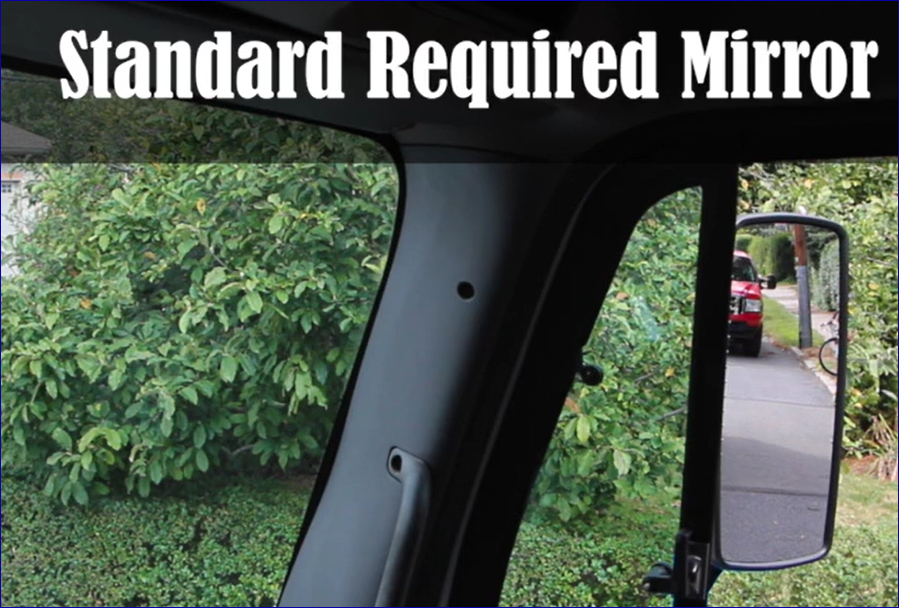


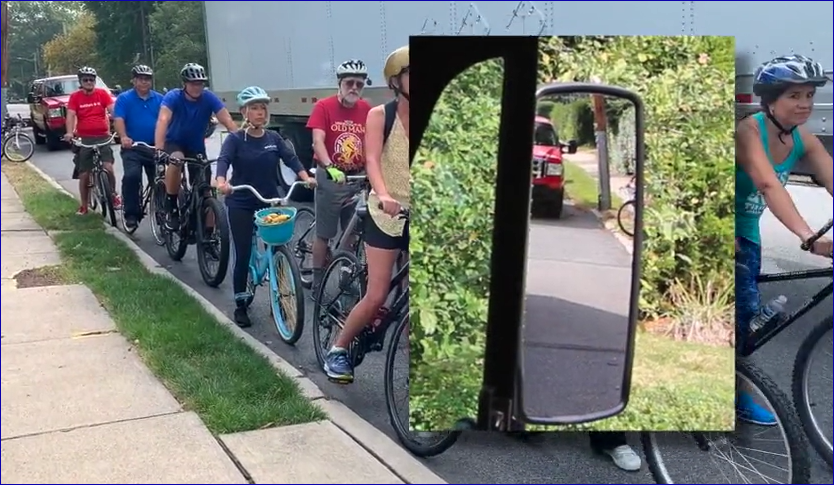

To view this discussion on the web visit https://groups.google.com/d/msgid/PBPAC/CABaJc7xeVLpOPhcdvCKXb3DuVK-2S_TPP5qxJCoxmqFw77KB-w%40mail.gmail.com.
Zack Barowitz
Jul 21, 2022, 6:31:19 AM7/21/22
to PB...@googlegroups.com
We had a meeting with city staff yesterday about bike lanes becoming shoulders and vice versa without warning (I learned that “fog lines” is the term for the line along the curb) so it seems like a hot topic.
As for the green paint, I like it. My theory is that most motorists are regular commuters and that they they “drive” the traffic flow. New green paint changes their habitats which remain after the paint has faded.
Zack
To view this discussion on the web visit https://groups.google.com/d/msgid/PBPAC/CAJg%3D2oyo4o0JfD14kSNPGp%3D%2B9-_L8sP8mu2FSRVqxW56MdAcXw%40mail.gmail.com.
917-696-5649
ZacharyBarowitz.com

ATTENTION:
The information in this electronic mail message is private and confidential,
and only intended for the addressee. Should you receive this message by
mistake, you are hereby notified that any disclosure, reproduction,
distribution or use of this message is strictly prohibited. Please inform
the sender by reply transmission and delete the message without copying or
opening it.
ZacharyBarowitz.com
ATTENTION:
The information in this electronic mail message is private and confidential,
and only intended for the addressee. Should you receive this message by
mistake, you are hereby notified that any disclosure, reproduction,
distribution or use of this message is strictly prohibited. Please inform
the sender by reply transmission and delete the message without copying or
opening it.
William Chabot
Jul 21, 2022, 10:48:20 AM7/21/22
to PB...@googlegroups.com
Not that it would be enforced, but I just learned recently that it is a violation to turn right in front of a cyclist:
1-A. Right turns near bicyclists or roller skiers. A person operating a motor vehicle near a person operating a bicycle or roller skis and proceeding in the same direction may not make a right turn unless the turn can be made with reasonable safety and without interfering with the safe and legal operation of the bicycle or roller skis.[PL 2013, c. 241, §2 (AMD).]
As someone who has been a victim of this (met the back of a car turning hard right at the bottom of State St just before the bridge), and of course as a driver, I had no idea this rule existed.
To view this discussion on the web visit https://groups.google.com/d/msgid/PBPAC/CAE741VAMFSVr71seZAPewHZZqFjAKCPLBhn6_4e8LomBRc%2B5xQ%40mail.gmail.com.
Zack Barowitz
Jul 21, 2022, 1:14:50 PM7/21/22
to PB...@googlegroups.com
It’s good to know especially if you have a go pro
To view this discussion on the web visit https://groups.google.com/d/msgid/PBPAC/CADqUAQ%3D8d4iivV7JLu_V0r5KAeZ7n_UbM%2BaSjQ_7GOHwPOMeLw%40mail.gmail.com.
John Brooking
Jul 21, 2022, 2:47:32 PM7/21/22
to PB...@googlegroups.com
Will, I’m curious, when you meet the back end of that car, was it directly in front of you and slowed suddenly, or was it to your left and turned suddenly?
To view this discussion on the web visit https://groups.google.com/d/msgid/PBPAC/CAE741VD2gjFS6XP%2Bewm36tLBj3kEMwCRZxC7CwfTcqw67GADGQ%40mail.gmail.com.
William Chabot
Jul 21, 2022, 3:34:27 PM7/21/22
to PB...@googlegroups.com
Both me and the car in front of me were coming down State St towards the Casco Bay Bridge. I was all the way to the right. We reached the intersection at York St (the last intersection before you are properly on the bridge) and a pedestrian with a shopping cart stepped off the sidewalk and into the street (right where I would be going). It was a green light, so the car pulled slightly to the left to avoid the pedestrian, and focused on the pedestrian so did I. The car made an unexpected hard right onto York St, rather than continuing over the bridge slowing down suddenly to do so (it's a sharp corner already, and he had to turn wide since he was so far left), and I jumped off my bike and it hit the back bumper of the car on the right side. The driver said something like "you must not have seen my blinker" and frankly that might have been true as I was focused on not running into the shopping cart man who decided to start his cross before he should have.
Fortunately no harm no foul, I was uninjured and the car and my bike both were relatively unharmed (less a few scratches on my handlebars from hitting the pavement) and I continued on my way to work. It certainly frightened me, as it was the first and only time I have been involved in any kind of collision.
Fortunately no harm no foul, I was uninjured and the car and my bike both were relatively unharmed (less a few scratches on my handlebars from hitting the pavement) and I continued on my way to work. It certainly frightened me, as it was the first and only time I have been involved in any kind of collision.
From then on I have ridden in the center of the lane coming down State St (as I do every day). The hill is steep, I cannot stop quickly, and the cars have a whole other lane they can use to go around me. People for the most part respect my space. When I get to the bottom of the hill, I pull to the left side of the right hand lane so that I could maneuver around a car if they decided to turn right onto York, and then move back onto the bike lane shoulder once I am safely on the bridge. The issue lies in the "slight right" as you come onto the bridge, which you may be tempted to signal at if you aren't familiar with the intersection, so you would have no way of knowing if someone is trying to go "straight" or turn onto York. I am certainly glad that that intersection is at least a one way onto York St as the visibility in that corner is limited. I can't imagine trying to pull out of York onto the bridge.
While I am on a rant, the crossing of the on ramp to the bridge immediately afterwards also sketches me out. I always yield and prepare to stop there, as there is a physical barrier and fence that limits visibility. I often have to wait for someone to stop before I can cross (even though it is signed and I have the right of way). It would be great to at least have a flasher there (like there is crossing the on ramp to the Veteran's bridge coming from South Portland- equally terrible). Honestly, the whole bridge experience is very unpleasant, but there is no other way to South Portland without going all the way around.
To view this discussion on the web visit https://groups.google.com/d/msgid/PBPAC/CAJg%3D2owmf_zUApT2v7P%2B-CmqkaQ2_BFYSgNTvT9eV%3D0gu_SZbQ%40mail.gmail.com.
Emilie Swenson
Jul 21, 2022, 10:26:14 PM7/21/22
to PB...@googlegroups.com
OOf, that sounds like a scary experience. Glad you were ok! Taking the lane definitely seems to be the answer.
You highlight a lot of issues there - I can relate to the crossing of the ramp onto the bridge - it is very sketchy.
Also love that you highlighted the statute AND that it specifies bikes AND roller skiers! Gotta love Maine - I can imagine that similar clauses in other states do not mention that mode of transportation/exercise...
To view this discussion on the web visit https://groups.google.com/d/msgid/PBPAC/CADqUAQkQ-hYPT_Og1nXWxsdUsxiSjbQeH7qGc9TAr_-rTbNZvA%40mail.gmail.com.
Corey Templeton
Jul 22, 2022, 11:34:45 AM7/22/22
to Portland Bicycle and Pedestrian Advisory Committee
As it relates to Will's post (I'd be happy to start a new thread named "design a better Casco Bay Bridge") there is a bike sign with flashers on the on-ramp, but I'm not clear if it works or how it is activated.
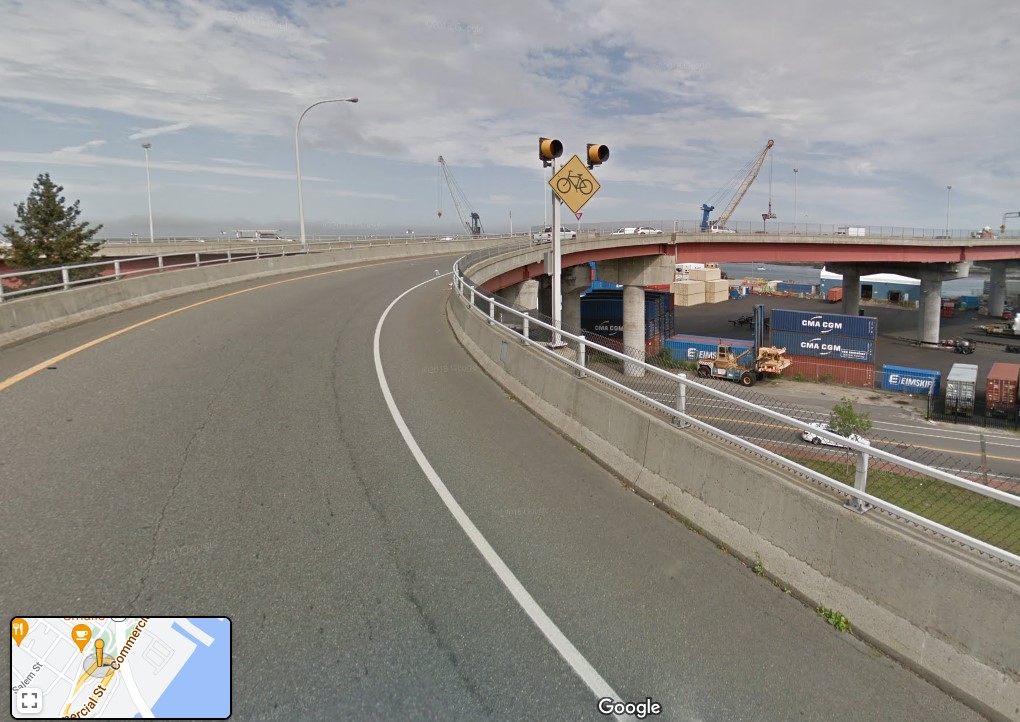
Also concerning that bike riders are instructed to "yield to ramp traffic ahead" which does not seem right. Shouldn't the cars coming up the ramp yield to all traffic already on the bridge?
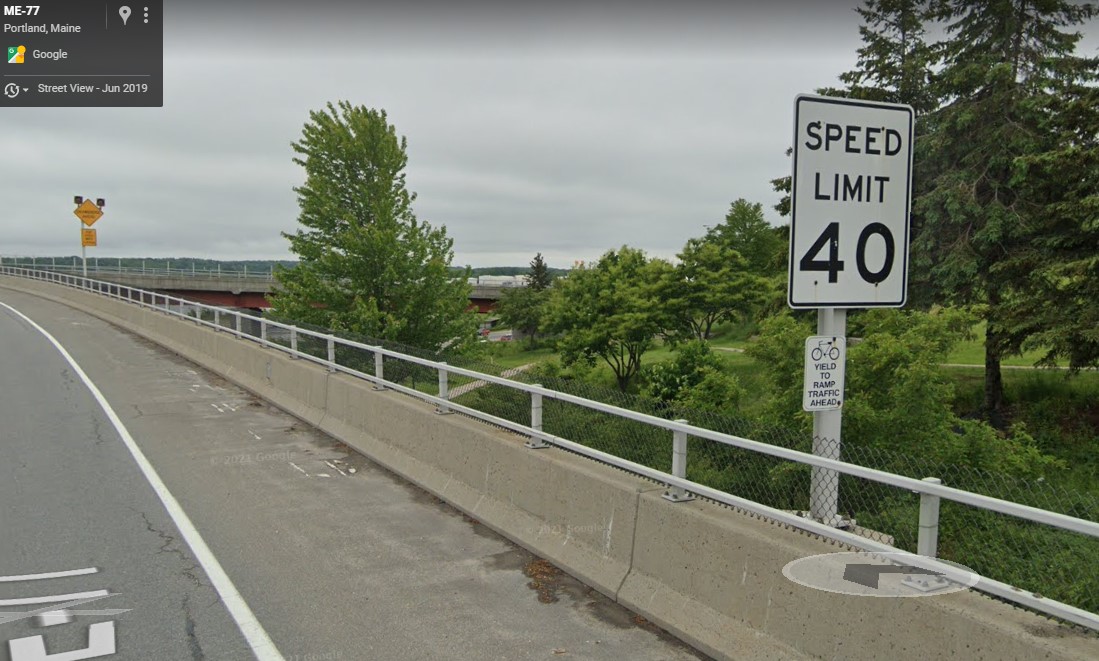
Corey Templeton
Jul 23, 2022, 12:56:28 PM7/23/22
to Portland Bicycle and Pedestrian Advisory Committee
And to steer back to the original topic, here's the top of Elm Street this morning. I'm not crazy about riding in a bike lane directly next to a line of buses, so personally would opt to ride in the "car" lane through here.
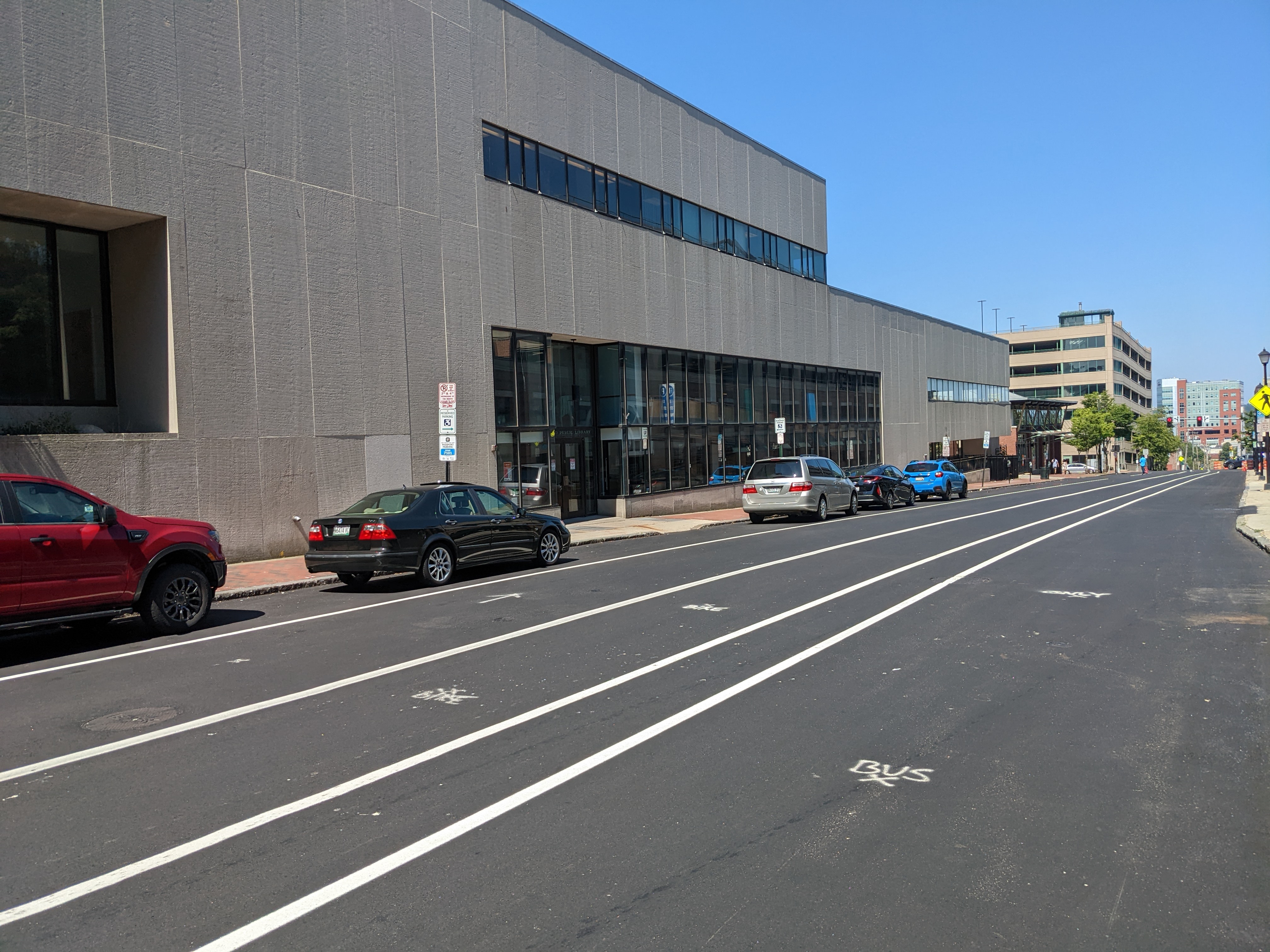

John Brooking
Jul 23, 2022, 4:02:45 PM7/23/22
to PB...@googlegroups.com
First, I too am glad you're okay, Will! (Obviously, we all are.)
The downhill issue is a general bike lane design issue that I feel like some traffic engineers don't take into account enough. (Not that there's a bike lane on State Street downhill to the bridge, but this is an excellent reason NOT to have one there. OTOH, centered sharrows would be cool, IMO.) I'm not thinking of any particular problems in Portland, but heard about a particularly dangerous one in Seattle, I think it was, that was actually a two-way separated lane. So you had cyclists, some inexperienced, passing driveways and other unsignalized intersections quickly from an unexpected direction. I'm not sure of the current status of that installation. But in general, I hope that bike lane designers remember to consider more than just flat width in their design decisions.
I recall that we saw the plan for this Elm Street design a year or so ago. When I first heard about it, I did initially have concerns about it being downhill. But I actually felt better about it after seeing the design, and having ridden in it last week, primarily because the bike lane is so wide, from having reduced the number of travel lanes (NOT "car lanes", please; framing matters) from two to one. There looks to be plenty of room to stay away from parked cars, and doesn't seem that much different geometrically and experientially than just riding in the rightmost of the two former travel lanes, which we'd all been doing safely for years. (Okay, I admit I haven't researched crashes there; but I never heard of any.)
As for the bike lane being next to buses at the Pulse, I haven't tried that part yet, but I'm not initially inclined to be too concerned about it. Obviously dooring is not a problem from buses, and there is a buffer to allow more visibility to pedestrians potentially walking out from in front of a parked bus. That will also put the cyclist in a more leftward position to be noticed
by bus drivers looking in their rear view mirrors before pulling out.
But the curb to curb width is still the same, so again I don't see a huge difference between that design and where we already ride. Of course cyclists still need to be wary of any bus with its left blinker on, as they always have.
To view this discussion on the web visit https://groups.google.com/d/msgid/PBPAC/dbe97795-7520-42e7-91c2-a0f26f2a2158n%40googlegroups.com.
Christopher Parelius
Jul 23, 2022, 5:16:45 PM7/23/22
to PB...@googlegroups.com
"...of travel lanes (NOT "car lanes", please; framing matters)"
I would argue that so long as the lane is designed primarily for motorvehicle throughput over bicyclist, scooter, scater...etc comfort that it's still a car lane. Only the most daring and physically fit will use them to bike in and it will discourage everyone else.
A vehicle lane should be comfortable for bicyclists scooters, scaters etc... of all skill levels and comfort levels. This would mean a design that discourages speeds over 20mph, have no turning lanes, and a max of one travel lane per direction.
-Chris
To view this discussion on the web visit https://groups.google.com/d/msgid/PBPAC/CAJg%3D2oy8oT0mUcE7j5GJxmpbwL7BUEVJi%3Dp7-ceZ7TYSFAsFGA%40mail.gmail.com.
Scsmedia
Jul 23, 2022, 6:02:37 PM7/23/22
to PB...@googlegroups.com
From the picture, I can say people are going to ignore this bike lane like the do on Preble Street coming up to Cumberland Avenue.
To view this discussion on the web visit https://groups.google.com/d/msgid/PBPAC/CAJg%3D2oy8oT0mUcE7j5GJxmpbwL7BUEVJi%3Dp7-ceZ7TYSFAsFGA%40mail.gmail.com.
John Brooking
Jul 23, 2022, 6:21:26 PM7/23/22
to PB...@googlegroups.com
My insistence is mainly in terms of cyclist rights. All travel lanes in Maine are legal for bicyclist use, except where explicitly posted otherwise. As far as I am aware, this prohibition is only on the interstates, and Route 1 between Brunswick and Bath. We all know that many motorists already don't know that cyclists have the right to be in the travel lane, especially if they are by necessity delaying car traffic, and many who are aware of that right disagree with it. Did you ever have a motorist tell you to "get out of the road"? I think we all have, if we've been riding any time at all. IMO, "car lane" reinforces that legally incorrect and harmful framing, so I continue to urge all bicycle advocates not to use it.
As to "most daring and physically fit", I think this overstates the requirement. Yes, you need some basic skills, like riding in a straight line, including when you are looking back over your shoulder or using hand signals, or going uphill. I may not ride at 8-10 MPH all the time, but I do so on steep uphills or facing a stiff headwind, and sometimes I'm controlling the lane while I do it. This is often portrayed as "daring", but I don't consider it as such. Rather, it's a confidence developed over time, very similar to the confidence you gain when you are first learning to drive a car. I didn't just start "taking the lane" from day 1; I don't know anyone who did. I would agree it's unrealistic to expect beginners to do this from the start, but I also think framing infrastructure as absolutely required for safety, as some advocates do (as opposed to comfort, to which I am more willing to admit), and downplaying the possibility of "normal people" to share travel lanes, is disempowering. People can learn over time, and just because they've learned doesn't automatically make them "daring and physically fit". What they are is more experienced and educated. (And education can help a lot, which is why I teach and promote CyclingSavvy. I've taught many less experienced riders how to use travel lanes and even multi-lane intersections when it is necessary.) If anything, I think I'm less daring than many cyclists I see doing more dangerous things than riding a straight line in the middle of a travel lane. Much of the time, it's actually pretty boring.
To view this discussion on the web visit https://groups.google.com/d/msgid/PBPAC/CAK%2BeAi_QiBL4GGaMUn2w8oA9orwWAw-YU%3DahJ%2Bkr5Pke_k3esA%40mail.gmail.com.
Christopher Parelius
Jul 23, 2022, 6:52:08 PM7/23/22
to PB...@googlegroups.com
I do agree with needing to emphasize cyclist rights to the road. However I still see this perspective as bringing cyclists and other human or low powered vehicles to the level of cars as opposed to the opposite. It's not comfortable nor safe to be sharing space with other road users who are allowed or encouraged to move significantly faster than you. This doesn't mean loosing our dignity but it does mean taming the behavior and speed of motorists so they can operate safely around us.
They usually get mad at us when we are moving much slower than the designed speed of the street. Design the street for bicycle friendly speeds and motorists won't feel like we're inhibiting them because faster speeds will feel dangerous.
This goes to the classic set of public space prioties used to bike friendly places outside the US: 1 Pedestrians, 2 cyclists (I include scooters hoverboards, skateboard etc in this category) , 3 transit, and 4) private motorvehicles.
-Chris
To view this discussion on the web visit https://groups.google.com/d/msgid/PBPAC/CAJg%3D2owUTxLx02_39Y5e%3DNV3mgBgGWw0NiBCadCD2PYYH-R9gg%40mail.gmail.com.
Winston Lumpkins
Jul 23, 2022, 7:17:33 PM7/23/22
to PB...@googlegroups.com
That's a good point about the habit forming- even a little remaining paint probably does something- though I think currently it's only used in conflict zones, such as through intersections, it will be interesting to see what they do here re- paint.
I think this plan must have come up before I was on the list, it's been around a year... I should look and see if I can find it, would be interesting to see the plan. I think it was me that started the "car lane" use in this thread... I was fumbling for the right wording. As I grow
into more of an advocate, it's very important for me to use language
that reflects the legal rights of bicycle drivers, very much in
agreement about that issue. Always open to hearing how I can improve, in all ways, not just linguistically.
One of my quite nightmares is of cycling infrastructure getting much better & some trying to legally require cyclists to use it where available, "for their own good" or "for the convenience of motor vehicle operators'', which I will always be 100% against, no matter how good it gets it won't be perfect, will sometimes be full of broken glass & sometimes you'll need to take a travel lane to get places in America...
I probably fit the "darring & physically fit" terminology better than most, but I don't think it's a very good description of everyone who rides the way I do- I can be extremely defensive, though sometimes you cannot hesitate... I would describe myself as Confident, just the right amount of afraid & physically fit- though honestly, the fitness is very optional to the way I ride & probably gets me into more trouble than it gets me out of. One of my quite nightmares is of cycling infrastructure getting much better & some trying to legally require cyclists to use it where available, "for their own good" or "for the convenience of motor vehicle operators'', which I will always be 100% against, no matter how good it gets it won't be perfect, will sometimes be full of broken glass & sometimes you'll need to take a travel lane to get places in America...
~Winston
To view this discussion on the web visit https://groups.google.com/d/msgid/PBPAC/CAJg%3D2owUTxLx02_39Y5e%3DNV3mgBgGWw0NiBCadCD2PYYH-R9gg%40mail.gmail.com.
Winston Lumpkins
Jul 23, 2022, 7:40:32 PM7/23/22
to PB...@googlegroups.com
I did do a little digging:
This is the Prior thread for this topic from over a year ago: https://groups.google.com/g/pbpac/c/dsdVxf7fYcE/m/9UMPM6KcAAAJ
These are some excellent notes taken by John Brooking (thanks John!) They include the plans!
HA. Only took a minute or 2 to find them :).
https://docs.google.com/document/d/19FR1vdFd1BMt3_DtoHzHZJUsL3LWaJ2UpZTobm7uPyM/edit
https://docs.google.com/document/d/19FR1vdFd1BMt3_DtoHzHZJUsL3LWaJ2UpZTobm7uPyM/edit
The final page of the notes shows the design for Somerset to Marginal Way- in the design the bike lane is on the outside of the right turning lane, with a dotted transition around the corner, where the infamous pinch point of TJ's is. I'm not sure that's what they did however :/ seems like it would eliminate the turning risk John & I are worried about...
Christopher Parelius
Jul 23, 2022, 8:06:53 PM7/23/22
to PB...@googlegroups.com
I noticed in the poll that business owners were overrepresented at 57% while both cyclists and transit riders were underrepresented at 14% each. If you combine those two they still only account for half as many as those who identify as business owners. Was this taken into consideration in the decision making process? It seems to me that both cyclists and transit riders' interests should be weighed in the name of equity. Business owners are more likely to have the time and ability to participate in public meetings so this may not be a representative sample of all the users as a whole. It also doesn't include people who would like to ride their bike around town but dont because they don't feel comfortable doing so.
-Chris
-Chris
To view this discussion on the web visit https://groups.google.com/d/msgid/PBPAC/CABaJc7xcBe3--y9qm3pYk7x5HteAcHCuj1bJ%3DZe61QQkQHRUgw%40mail.gmail.com.
John Brooking
Jul 23, 2022, 9:10:21 PM7/23/22
to PB...@googlegroups.com
Christopher, I simply cannot agree with your assertion that it is unsafe to share space with faster-moving vehicles. I would agree that it can be unsafe, especially when the cyclist is not being aware of their surroundings and/or not following the same rules of movement as motorists. And yes, sometimes things can happen that are beyond a cyclist's control. But I won't agree to a blanket statement. The long personal experience of thousands of cyclists disproves it.
My story: I have been riding an 11-mile
round trip to work and back for about 20 years, plus other local trips, year-round. It's mostly rural and suburban roads, with some usable shoulders, which I do use, but also some 4-lane roads with no shoulder (near the mall), and no bike infrastructure anywhere on my commute. I've had some close calls, but I've been hit semi-seriously exactly once. (And brushed lightly with no injury twice more that I can remember.) That one time was on a 4-lane road at night, in the rain. I had lights, but the car's windshield wipers weren't working and the driver was trying to get home anyway. You could of course make the case that this is exactly the kind of unpreventable situation that makes it so unsafe. I choose to counter that it's the exception that proves the rule. It took such an extreme combination of factors for me to get hit. For years before and after that, I have travelled in the middle of the lane in that same area without getting hit. Every damn weekday (slightly less since Covid). So yes, it can be unsafe, but not categorically. As I said before, I find the fear-mongering disempowering.
I've actually been doing a "passing study" for the last month. I count the number of cars that pass me whenever I'm
riding in the middle of a lane
on a 4-lane road, including the number of them that have been less than a full lane change, and/or the driver honked or yelled at me. The ratio of both of those are averaging around 0.5%, out of over 1800 passes so far, closing in on 100 miles total. And the number of close calls of any kind: 0.
This is not to minimize the experience of cyclists who have had more serious injuries or been killed, or to victim-blame.
To view this discussion on the web visit https://groups.google.com/d/msgid/PBPAC/CAK%2BeAi_%2BZsuVG%3Df3rH2HbSyAsA-NgfGq%2ByXU1N%2Bu1tDykap48w%40mail.gmail.com.
John Brooking
Jul 23, 2022, 9:17:07 PM7/23/22
to PB...@googlegroups.com
Winston, thanks for digging up that document that I had forgotten all about! :-)
Yes, they apparently changed the design at Marginal Way. I wouldn't be surprised if they decided a combination through/right turn lane was better than a right-turn only lane, for whatever reason (yes, probably motor traffic flow), and so were unable to bring the bike lane out. OTOH, I often dislike the situations shown on the plan as well, where the bike lane is between a through lane and right-turn only lane. It often feels too constricted to me. Imagine being between two trucks. Fortunately, we have the right to leave the bike lane and use the through travel lane if we want, and IMO it's the better option in both designs. So dash it. :-)
Christopher Parelius
Jul 24, 2022, 7:35:57 AM7/24/22
to PB...@googlegroups.com
The data says otherwise. When bike infrastructure is built the number of people who ride their bikes increases dramatically. This says something about how most people feel about riding with motorvehicles.
When you refer to the experience of thousands of cyclists who are able to safely ride on roads designed for motorvehicles is this in North America or globally? People who choose to ride their bikes in places with minimal or no bicycle infrastructure are a self selected group of people who may not be representative of the desires or comfort levels of the vast majority of the public.
Why should we judge our worth in terms defined by the automobile or use autocentric framing? Why should bicyclists have to follow road rules made specifically for automobiles and not for us in mind, instead of advocating for a public realm designed to be comfortable for all of us?
I would argue that it's more empowering for a larger percentage of people to be able to navigate their community on a bicycle or some other similar form of transport comfortably without having to resort to special training, defensive maneuvers, or an assertive mentality. These are all coping mechanisms understandibly developed as a reaction to car centric planning but now serve to limit the scope of our activism and hinder a truely bike friendly public space.
At the end of the day the public realm in the United States is largely monopolized by the needs of the automobile when in urban areas it shouldn't be. Cars don't need to be driving more than 20mph (I respect George for bringing this point up in the notes) in urban areas. As the more vounerable and slower users the public realm should be designed with their needs and capabilities first with followed by progressively faster and more powerful users.
Long story short, I don't want to be a car or have to fit into the mold defined by the car. I just want to comfortably use public space on my own terms as a person on a bicycle. That's empowerment.
-Chris
To view this discussion on the web visit https://groups.google.com/d/msgid/PBPAC/CAJg%3D2ox-qtJxHs2eVyjYUDNWXroOK%2BOAHN6kKXDjwgmt65ey%3DA%40mail.gmail.com.
Chuck Lerch
Jul 24, 2022, 12:21:08 PM7/24/22
to Portland Bicycle and Pedestrian Advisory Committee
John and Chris, thanks for your thoughtful posts on safety and design. Nomenclature aside, I find myself agreeing with you both. Significant increases in cycling will require infrastructure that makes most would-be road cyclists feel safe enough to even try it. In the meantime, supporting cyclists to use existing streets and roads will at least help people who are motivated (and feel safe) shift to cycling, and hopefully become advocates for revamping infrastructure.
Safety and risk are subjective and personal. I used to (25 years ago) commute daily from in-town Portland to Westbrook via Outer Congress. I don't think I'd feel safe enough to do that today, not because it's riskier now but because my risk assessment/tolerance has changed.
Chuck
John Brooking
Jul 24, 2022, 4:20:15 PM7/24/22
to PB...@googlegroups.com
Chris, my dispute is specifically with your sentence "It's not comfortable nor safe to be sharing space with other road users...", specifically the "nor safe" phrase.
I don't dispute the claim that people feel uncomfortable on roads lacking bicycle infrastructure. Peoples' feelings and risk assessments are their own, and not to be expected to match mine. But to say just "it's not safe to share space with car drivers" without any qualification whatsoever is just not accurate, as I tried to explain. I would maybe agree to a more qualified assertion, but really, it comes down to what you define as "adequately" safe (because people are killed in bicycle infrastructure too), and we probably won't agree on where that line is, if it can even be quantified, so let's not go down that rabbit hole.
As you say, some people may be empowered to try riding if they're given separate space at first. People can also be empowered to try riding, or to ride more, by receiving education about how to be more confident riders, whether or not there is separate space. Maybe education can play a role in taking those riders who are initially enticed by the infrastructure, and want to go more places but feel held back by the lack of infrastructure. Education can get them there, figuratively and literally!
The role of bicyclist education is not, and has never been, enticement. It is empowerment. It's going to take years and many dollars to get to the separation nirvana you envision, if we ever do. Meanwhile, climate change is upon us, it has been for some time, and frankly, reconstructing our entire transportation system is a pretty carbon intensive process, what with all that new asphalt and the big diesel machinery that puts it all together. Education can get people where they want to go by bike NOW. That's why I'm so sensitive to hearing categorical statements about the danger of sharing space with cars. I know from experience that's not true. Saying it is, is discouraging to people who want to ride NOW. Infrastructure may empower people to ride where there's infrastructure. Education can empower them to ride anywhere. Can we agree that both are valuable?
To view this discussion on the web visit https://groups.google.com/d/msgid/PBPAC/568dec12-71ca-4d0e-9b17-72bf75edce08n%40googlegroups.com.
Christopher Parelius
Jul 25, 2022, 12:47:56 PM7/25/22
to PB...@googlegroups.com
I agree that getting people to ride now is important however I'm not advocating for separatate infrastructure. What I'm advocating for is rethinking the space that is currently primarily designed for automobiles to be redesigned in a way that everyone, including pedestrians, can use at their own speeds in a shared space.
Think of the woonerf or many of old medieval centers of European cities. You don't need massive investments in heavy machinery or asphalt to achieve this as is evident under Sadik Khan's tenure in NYC. Planters, street furniture and paint can transform the space over night with little to no money.
In spaces like this you don't need special training or education beyond how to operate the bicycle to navigate them for the same reasons that you don't need special training on how to walk down the sidewalk or a plaza. Conflicts are easily resolved and intuitively negotiated because the lower speed allows more time to do so. When mistakes do happen the lower speed means that injuries are less serious.
The flows into reason why cyclists still get killed in bike lanes which is because the motorvehicles on the streets becide them are still encouraged to move fast enough that mistakes not only are easier to make because there is less time to react and when impacts happen they happen at speeds that will seriously injur or kill cyclists. This is why I see speed as important.
-Chris
To view this discussion on the web visit https://groups.google.com/d/msgid/PBPAC/CAJg%3D2oywXTkoBqKYkXjq%2BoO9kvp03dgKEH_ReJuSnB3vTiF8KA%40mail.gmail.com.
John Brooking
Jul 26, 2022, 9:18:15 AM7/26/22
to PB...@googlegroups.com
We agree that speed is one of the primary factors in making a situation safe or dangerous. I'm all for slowing cars down. (Side note: People like to criticize Westbrook for not being very receptive to installing bike infrastructure, but I will say that the Director of Public Services understands the need to slow traffic, based on conversations I've had with him. And in two locations in Westbrook now in the last few years, a right turn "slip lane" has been removed and replaced by a standard right turn requiring a stop. So there's that.)
Getting back to the topic, I had the chance to try Elm Street again last night. Unfortunately, there were no buses parked at the Pulse at the time, so I wasn’t able to try that stretch in their presence.
I did notice, however, a few sections of bike lane along the parked cars. Both the parking lane and the bike lane are plenty wide, so I'm not going to go into a full-out door zone bike lane rant on this like I sometimes do. However, in my opinion, the buffer here still belongs on the door side. I wish they had done that. I won't bother going into my reasoning unless you want me to. Basically, I know people are more scared of the moving traffic on their left than opening doors on the right, but I think the opposite is actually true.
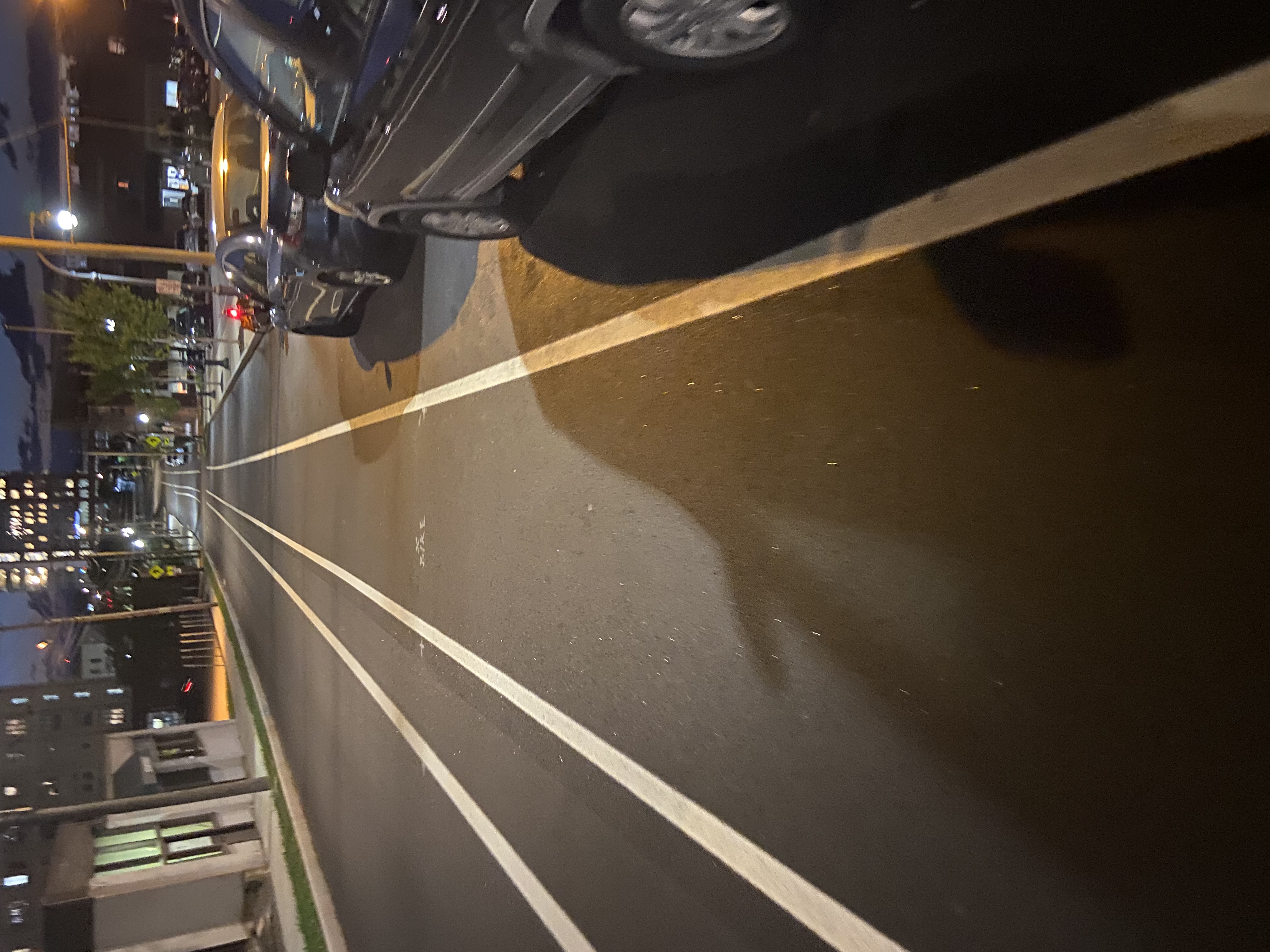
To view this discussion on the web visit https://groups.google.com/d/msgid/PBPAC/CAK%2BeAi8RfhCMrW-MVKfH%3DLVkxLwYLXPG%2BW%2BpCkC2LFNWedjJ-A%40mail.gmail.com.
Winston Lumpkins
Jul 26, 2022, 6:51:18 PM7/26/22
to PB...@googlegroups.com
I'm of the opinion that door zones are a matter of education- regardless of a buffer, some people feel safer there, and will ride there no matter what. Our only hope of saving them is to have a chat about always riding 3-4 feet away from parked cars before they get doored, or some sort of public awareness campaign. I agree though, that a door zone buffer might be more useful than a buffer on the car side, but I'm unsure if it makes any difference. Some idiot will park 3 feet from the curb eventually, so, it doesn't really matter where the line is, you still have to keep your eyes open and avoid the door zone.
I was riding with a friend today on such a bike lane (travel lane side buffer) & he rides in the buffer, as it gives him somewhere to his right to go if there's a close pass, and there's less likely to be debris in the buffer than the bike lane. People are just gonna do what they're gonna do. I went and Emailed Jeremiah Bartlet (Transportation Systems Engineer with the Portland DPW) & he sent me this revised diagram:


(Link for digest users: https://drive.google.com/file/d/1L0U3PxYE8NlxZAeNxgf8eQj1OAN6KHzS/view?usp=sharing)
they had concerns about the initial design with this high volume intersection and decided that it would be more appropriate to use a "Bike Box" (for listserv members unfamiliar with the term: https://nacto.org/publication/urban-bikeway-design-guide/intersection-treatments/bike-boxes/) than the initial design.
I think it might be appropriate for this intersection- I think this will be a bike box's first use in Portland?
I haven't used one, but, I think, if trucks comply of course, they will make the bad habit of sidling up next to trucks a bit safer, and I doubt we're going to be able to get to everyone before they get right hooked, dashed line or no... It falls under my personal creed of "just go ahead and make the stupid thing safer".
~Winston
To view this discussion on the web visit https://groups.google.com/d/msgid/PBPAC/CAJg%3D2oz%2B%2B0wRPnm5LHrW%3D9-zzQOuT5pNWs4t8cazxJmVs8g3%2Bw%40mail.gmail.com.
John Brooking
Jul 26, 2022, 7:41:25 PM7/26/22
to PB...@googlegroups.com
I'm not a fan of bike boxes. Portland may already have one, depending on whether you think this non-standard thing on Forest Avenue outbound approaching Falmouth Street is a "diagonal bike box" (which I've never seen in any design manual), or something else. (A bike lane leading across the front of the queue to the left turn lane? [Where I wonder if the light will detect them if they're the only one there.])
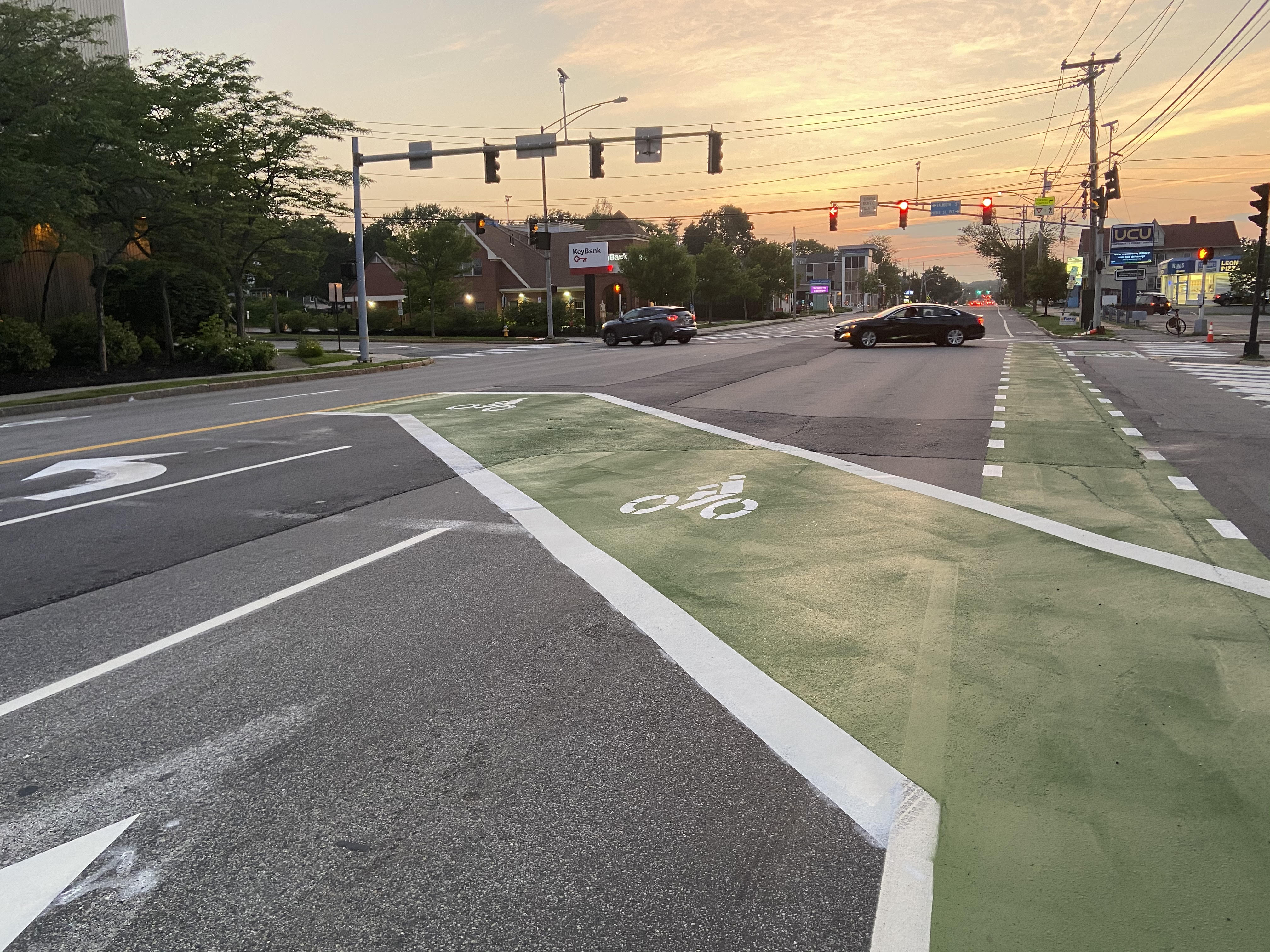
Problems I see with bike boxes (and these are not just my opinions, but that of many other bicycle educators nationally):
- To begin with, they only work half the time, when the light is red. When it's green, you're still riding through the intersection at the edge, same as a regular bike lane, with all the same conflicts.
- How is the cyclist to know when a red light is about to change to green? It might happen while you're still riding up on the right side, or worse, just about to cut over.
- Same danger even before the red turns green unless right on red is prohibited and obeyed.
- A multi-lane one such as this re-creates those opportunities for conflict in each lane. (In this diagonal design in particular, you've got the cyclist approaching the first car in each lane from behind them, to their right, through a blind spot. What could go wrong?)
- The advertised advantage is to get the cyclist in front of the first car, where they are visible, but even that is not nearly as effective as the cyclist just getting in line with the traffic. Said cyclist is naturally in front of the first car that arrives after them, and doesn't have to worry about any of the cars in front of them. The bike box is a half-solution compared to stopping in the line, and one that violates "first come first served".
Regarding the buffer side of a "door zone bike lane", the bottom line for me is that the infrastructure should guide best practice behavior, not guide the opposite. We can't control whether people follow it, but at least don't have the paint teach them the wrong thing. That borders on liability, to my mind. It breaks my heart to read about a dooring fatality and everyone is pleading with motorists to be more careful, but no one points out that cyclists have the right to avoid the door zone. (Of course, such a context is never a good time for other cyclists to bring that up; they may mean it in the spirit of protecting the next person, but they inevitably get accused of blaming the victim. So we need to take every other opportunity to say it and teach it, outside of the emotional context of a fatality.)
To view this discussion on the web visit https://groups.google.com/d/msgid/PBPAC/CABaJc7w5085Z49OQ4HtKoCoeSqKNmGc4Y5Yq%3DuGtHLgj4TAETQ%40mail.gmail.com.
Scsmedia
Jul 26, 2022, 7:51:42 PM7/26/22
to PB...@googlegroups.com
We have several bikeboxes in Portland including already fading ones on Park Avenue and the ill conceived one at Forest Avnue and Falmouth Street.
As I noted in a previous post, bike lanes that are too large will be completely ignored. Watched a Jeep drive right down the bike lane on Elm Street for a block and a half. I was driving and could not get my phone out to take a picture. Even if we painted it green, the drivers would ignore it.
Steven Scharf
On Tue, Jul 26, 2022 at 6:51 PM, Winston Lumpkins<winston....@gmail.com> wrote:
To view this discussion on the web visit https://groups.google.com/d/msgid/PBPAC/CABaJc7w5085Z49OQ4HtKoCoeSqKNmGc4Y5Yq%3DuGtHLgj4TAETQ%40mail.gmail.com.
John Brooking
Jul 26, 2022, 8:51:37 PM7/26/22
to PB...@googlegroups.com
>
We have several bikeboxes in Portland including already fading ones on Park Avenue
Are you thinking of two-stage left turn boxes? They are a different thing. I don't recall any of what I'm calling bike boxes on Park Avenue.
Bicycle Box

Two-Stage Left Turn Box
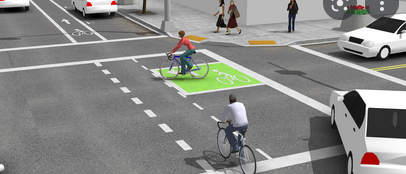
To view this discussion on the web visit https://groups.google.com/d/msgid/PBPAC/702266817.2621552.1658879483050%40mail.yahoo.com.
Reply all
Reply to author
Forward
0 new messages
